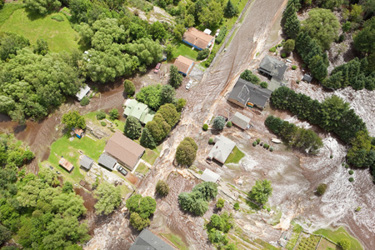Flowing With Feedback: Empowering Communities With The EPA Flooded Homes Cleanup Guidance Tool
By U.S. EPA

Extreme weather events such as tropical storms and heavy rainfall present a variety of challenges for communities across the country. Flooding is one of the most common types of natural disasters impacting people in the United States. A flooded home can result in various health hazards, in addition to financial and social challenges for homeowners and their families. In many cases it takes weeks for people to re-enter their homes after a flood event, and failure to remove contaminated materials before re-entering a flooded home can increase risk of long-term health impacts. Standing water and wet materials can contain microorganisms such as viruses, bacteria, and mold. Unfortunately, not all homeowners are aware of the health hazards or what to do when experiencing a flood. To address this issue, EPA scientists developed a website to inform the public about flooding-related health hazards.
The EPA Flooded Homes Cleanup Guidance website provides tips and informational videos for people impacted by flooding to prepare for re-entering their home and beginning cleanup. The site also explains the different health risks associated with flooding such as asbestos, mold, and lead paint.
To develop the website, EPA scientists worked with the Florida Department of Health (FDOH), the University of Florida Institute of Food and Agricultural Sciences (UF/IFAS), the Louisiana State University AgCenter, and St. Bernard Project (a nonprofit disaster relief organization in Louisiana) to conduct interactive community outreach. This effort incorporated the principles of human-centered design, a social science approach that focuses on people’s behavior, mentality, and needs. The UF/IFAS and FDOH connected the team with flood victims in the Panama City Beach community, and the LSU AgCenter connected the team with flood victims from Louisiana. These communities provided feedback, including information on how to improve the relevancy of the website and the effectiveness of the educational materials.
The research team began their community engagement with interviews to gain a better understanding of the flood victims’ experiences. Interviewees shared their personal flood stories so the team could understand where to focus efforts and how to meet their needs. The interview findings showed that the timing in which flood victims looked for assistance varied. Some people indicated that they looked for assistance during the beginning of their flood cleanup process, while others waited until after initial cleanup or when awaiting approval to re-enter their home. To address this, the website is organized to allow users to access the material from multiple points, as opposed to a linear progression approach where users might need to start at the beginning and search through the pages to find the information most relevant to them.
The topics of highest interest to the communities included mold, floor, and drywall cleanup, and standing water removal. The research team realized that the initial build of the website did not suit the needs of those interviewed, so they modified the site to better reflect community feedback. Community members preferred information provided from someone who has also experienced flooding, using terminology familiar to the community. The team captured the priorities, needs, and intentions of the users by considering factors such as emotional needs, health-related concerns, and the well-being of family members. Researchers succeeded in building community trust by taking the time to understand their challenges and providing support to help them make informed decisions.
“The research team flipped EPA’s traditional risk communication strategy. Instead of telling people what to do, we asked them what they wanted to hear,” said EPA researcher Dr. Keely Maxwell.
The website consists of four main sections: Coming Home, Doing it Yourself, Protecting Your Health, and Additional Resources and Help. Each of the sections include videos and reenactments that provide users with guidance on various scenarios. Representatives from the St. Bernard Project served as the actors for the instructional and educational videos.
“The Flooded Homes Cleanup Guidance Website is the perfect example of successful partnership between multiple EPA offices, and state and local partners. Together, we were able to provide clear, useful information to help individuals protect their health when cleaning up flooded homes,” says Acting Region 4 Regional Administrator Jeaneanne Gettle. “It has become a helpful resource for communities impacted by natural disasters. We anticipate that communities will rely on the guidance more frequently as the impacts of climate change make flooding events more widespread and severe. Region 4 hopes to continue to be an example of these collaborative efforts with ORD that furthers EPA’s mission of protecting human health and the environment.”
The website is relevant to communities impacted by disasters involving water intrusion. The impact of this tool has national significance for addressing the needs of communities impacted by flooding to help improve their health and well-being. The human-centered design approach and the involvement of actual community members affected by flooding helped ensure the website addressed the needs, interests, and values of the community and provided the information in a user-friendly manner.
